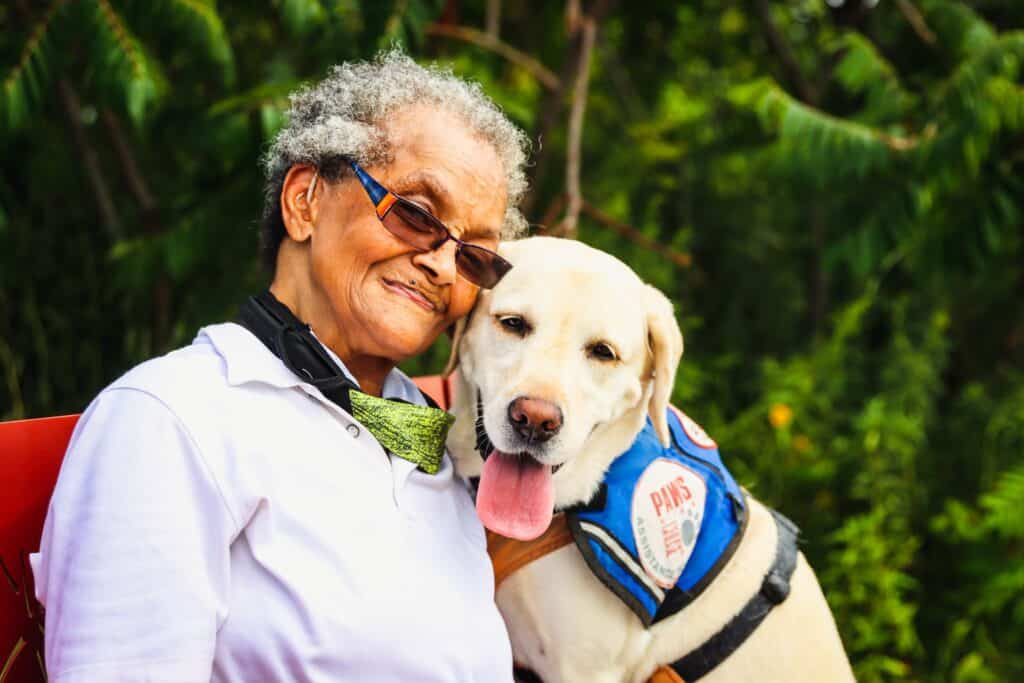
Introduction: The Healing Paws of Therapy Dogs – Canine Companions in Mental Health Care
In today’s fast-paced world, where mental health issues are becoming more visible and widely discussed, the search for effective and compassionate therapeutic approaches has never been more critical. This quest has led to a remarkable and heartwarming intersection: the world of therapy dogs and mental wellness. These canine companions, with their unconditional love, innate sensitivity, and empathetic presence, are emerging as vital contributors in the realm of mental health care. Known for their therapeutic impact, therapy dogs — or ‘canine therapists’ as some fondly call them — play a transformative role in supporting and healing individuals grappling with various psychological challenges.
This article aims to explore the profound and multifaceted role of therapy dogs in mental health. These four-legged therapists, with their unique ability to offer comfort and understanding, have become more than just pets; they are partners in healing, providing invaluable support in the journey toward emotional and mental well-being. From their empathetic responses to their calming presence, therapy dogs are not only enhancing traditional therapy methods but are also redefining them, offering a special kind of healing that only a non-human companion can provide.
As we delve deeper into the world of animal-assisted therapy and its benefits, we will uncover the stories, the science, and the soulful connections that define the bond between therapy dogs and those they help. This exploration will not only shed light on the effectiveness of these compassionate canines in mental health care but also celebrate the unspoken, yet profound, language of healing they share with humans. The journey through this article will reveal how therapy dogs are not just aiding in the treatment of mental health conditions but are also touching and transforming human hearts and minds in ways that go beyond the conventional.

The Rise of Therapy Dogs in Mental Health
The integration of therapy dogs into mental health care is a fascinating evolution, marking a shift towards more holistic and compassionate treatment methods. While the concept of therapy dogs isn’t novel, their application in mental health settings has witnessed a notable surge in recent years. This increase can be attributed to a growing recognition of the multifaceted benefits these canine companions bring to therapeutic environments.
In a variety of settings – hospitals, schools, nursing homes, private therapy practices, and even disaster zones – therapy dogs are becoming a common and welcomed presence. They are not just pets; they are trained to provide comfort and support, acting as co-therapists in many instances. In hospitals, they visit patients who are undergoing stressful treatments, offering a moment of respite and joy. In schools, especially those with children who have special needs, therapy dogs aid in improving social interactions and reducing anxiety among students. Nursing homes see these dogs bringing cheer to elderly residents, many of whom experience loneliness or cognitive challenges such as dementia. Private therapy sessions are also transformed with the presence of a therapy dog, where they assist in breaking down barriers between the therapist and client, creating a sense of safety and non-judgmental space.
The American Psychological Association has observed a significant rise in animal-assisted therapies, particularly highlighting the role of dogs in this realm. Their acknowledgment is not without evidence; numerous studies have demonstrated the therapeutic potential of animals, especially dogs, in treating a range of mental health issues. Conditions like depression, anxiety, post-traumatic stress disorder (PTSD), and even autism spectrum disorders have been shown to benefit from interaction with therapy dogs. The psychological impact is profound – these dogs provide a unique form of companionship that fosters emotional well-being, reduces feelings of isolation, and even lowers stress levels.
Moreover, therapy dogs are increasingly part of targeted mental health interventions. For instance, in treating PTSD, therapy dogs have been used to provide comfort during difficult therapy sessions, helping patients process traumatic memories in a safe environment. For those battling depression, the mere act of petting a dog can release endorphins and produce a calming effect. In the realm of anxiety disorders, the predictable and steady presence of a therapy dog can provide a grounding influence, helping individuals to manage their anxiety more effectively.
The rise of therapy dogs in mental health care is a testament to the growing understanding of the complex interplay between emotional well-being and the presence of compassionate, non-human companions. As we continue to explore and embrace these bonds, therapy dogs stand as silent, steadfast allies in the journey towards mental and emotional healing.

Personal Stories of Transformation
The true essence and impact of therapy dogs are most vividly captured through personal stories of transformation. These narratives highlight the profound difference a therapy dog can make in an individual’s journey towards mental wellness.
Take the case of Sarah, a college student struggling with severe anxiety. Amidst the stress of academics and the pressures of campus life, Sarah found herself battling overwhelming anxiety attacks and social withdrawal. However, her weekly sessions with Max, a compassionate golden retriever therapy dog, became a beacon of hope. Max provided more than just a furry presence; he offered a safe and non-judgmental space for Sarah. During their sessions, Max would calmly sit by her side, offering his head for a gentle pat or resting his paw on her knee, grounding her when the waves of anxiety seemed insurmountable. These moments with Max helped Sarah to open up about her anxieties, and gradually, she learned to manage her symptoms better. The therapy sessions became a crucial part of her support system, helping her navigate her college years with greater confidence and less fear.
On a different spectrum, consider John, a war veteran who returned home bearing the invisible scars of PTSD. Haunted by traumatic memories and struggling with hypervigilance and nightmares, John found everyday life to be a constant battle. Traditional therapies had limited success until he was introduced to Bella, a Labrador Retriever specifically trained to work with PTSD patients. Bella seemed to have an innate sense of when John was becoming overwhelmed. She would gently nudge him during moments of distress, breaking the cycle of traumatic flashbacks. Her constant presence during therapy sessions and at home provided a sense of security and calmness, slowly helping John to rebuild his sense of safety in the world. Bella’s companionship also encouraged John to venture outdoors more often, engage in physical activity, and gradually reconnect with his community, all critical steps in his recovery process.
These stories of Sarah and John are but two examples among countless others, each unique yet bound by a common thread – the remarkable, life-altering companionship of a therapy dog. In these companions, individuals find an empathetic friend who asks for nothing in return but offers everything in their silent support and unwavering loyalty. The transformation witnessed in Sarah and John’s lives underscores not just the effectiveness but the necessity of integrating therapy dogs into mental health treatment plans. Their stories serve as powerful testaments to the healing that can occur when human resilience is supported by the unconditional love and presence of a therapy dog.
Scientific Backing for Therapy Dogs
The therapeutic benefits of dogs extend beyond heartwarming anecdotes and have a solid foundation in scientific research. This body of evidence underscores the physiological and psychological impacts of human-animal interactions, particularly those involving dogs.
Central to understanding the science behind therapy dogs is the hormone oxytocin, often dubbed the ‘love hormone’ or ‘bonding hormone.’ Studies have shown that when humans interact with dogs, their oxytocin levels rise. This increase is significant because oxytocin is associated with emotional bonding, empathy, and trust. It plays a crucial role in social bonding and may be pivotal in enhancing the therapeutic alliance between patients and therapists. The presence of a therapy dog can foster a sense of connection and trust, making therapy sessions more effective.
Conversely, cortisol, known as the ‘stress hormone,’ decreases during interactions with therapy dogs. Elevated cortisol levels are often associated with stress, anxiety, and physiological symptoms like increased heart rate and blood pressure. The interaction with therapy dogs has been shown to reduce these cortisol levels, indicating a decrease in stress and anxiety. This effect is particularly beneficial in therapeutic settings, where reduced stress can lead to more productive sessions and better patient outcomes.
A landmark study conducted by the National Institutes of Health (NIH) provides compelling evidence supporting the efficacy of therapy dogs in mental health treatment. In this study, patients who participated in therapy sessions accompanied by a dog showed more significant improvements in mood and social interactions compared to those undergoing traditional therapy methods. These findings are critical as they suggest that the presence of a dog can enhance the effectiveness of traditional therapy techniques. The patients exhibited not just a temporary upliftment in spirits but also demonstrated long-term improvements in areas such as emotional regulation, social engagement, and overall psychological well-being.
Another critical aspect of this scientific backing is the role of therapy dogs in specific therapeutic processes. For instance, in exposure therapy for anxiety disorders, the presence of a therapy dog can provide the necessary emotional support to help patients face and overcome their fears. Similarly, in therapeutic settings for children with developmental disorders or for elderly patients with dementia, therapy dogs have been found to improve engagement and responsiveness.
This scientific backing paints a holistic picture of the role of therapy dogs in mental health care. It’s not just about the warmth and companionship that these animals provide; there’s a measurable, biochemical impact that these dogs have on individuals undergoing therapy. This scientific understanding reinforces the importance of integrating therapy dogs into mental health practices and encourages a broader acceptance of animal-assisted therapy as a legitimate and effective treatment modality.

Breeds that Shine in Therapy
The world of therapy dogs is diverse, with certain breeds standing out for their natural aptitude in therapeutic settings. While it’s true that almost any dog can be trained to be a therapy dog, some breeds exhibit innate qualities that make them particularly suited for this role. These breeds are known not just for their physical attributes but more so for their temperament, behavior, and ability to connect with people.
Labrador Retrievers are often the first that come to mind when thinking of therapy dogs. Their friendly and outgoing nature, combined with a strong desire to please, makes them ideal for interaction with a wide range of individuals, including children and the elderly. Labradors are often seen in hospitals and schools, where their calm demeanor and tolerant personality make them perfect for providing comfort and companionship.
Golden Retrievers are similarly valued in therapy work. Known for their gentle and affectionate nature, they have a remarkable ability to adapt to different environments and individuals’ needs. Their intuitive sense of human emotions makes them excellent at providing emotional support during therapy sessions. They are often used in scenarios where patients need a non-threatening presence to open up and express their feelings.
Poodles, with their high intelligence and hypoallergenic coats, are also a popular choice in therapy settings. They are particularly suitable for individuals with allergies. Poodles are known for their keen social intelligence and are often quick to pick up on subtle human cues, making them sensitive and responsive therapy animals.
Interestingly, the German Shepherd, a breed typically associated with guarding and police work, also shines in therapy. While it may seem counterintuitive to include a breed known for its protective instincts, German Shepherds possess a unique set of traits that make them excellent therapy dogs. They are highly intelligent, loyal, and have a calm confidence that can be immensely reassuring in therapeutic settings. Their ability to be trained to a high level of obedience and their keen sensitivity to human emotions make them particularly effective in scenarios where a strong, reassuring presence is needed, such as in therapy sessions for individuals with severe anxiety or PTSD.
It’s important to note that beyond the breed, the individual dog’s personality plays a crucial role in their effectiveness as a therapy dog. Temperament, the ability to handle stress, and a friendly disposition are key characteristics that determine a dog’s suitability for therapy work. The right match between a dog’s personality and the therapeutic needs of individuals they are assisting is fundamental to the success of any animal-assisted therapy program.
In essence, breeds like Labrador Retrievers, Golden Retrievers, Poodles, and even German Shepherds, with their respective qualities, contribute uniquely to therapy work. Each breed brings its own set of strengths to the table, enriching the therapeutic experience and providing invaluable support to those in need of comfort and healing.
Training and Journey of a Therapy Dog
The path to becoming a therapy dog is a journey of dedication, training, and a deep understanding of human emotions. This journey is not just about teaching a dog commands, but about nurturing an innate sense of empathy and developing the ability to respond appropriately in a variety of emotional and physical environments.
The initial phase of a therapy dog’s training focuses on basic obedience. This is where the dog learns fundamental commands such as sit, stay, come, and down. However, therapy dog training goes far beyond these basic commands. Dogs are trained to be comfortable and obedient in a wide range of environments, from the quiet of a library to the hustle and bustle of a hospital ward. They must remain calm and composed, regardless of the surroundings or the level of activity around them.
Organizations like Therapy Dogs International and Pet Partners are pivotal in this journey. They offer structured certification programs that ensure a dog possesses the temperament and skills needed for therapy work. These programs rigorously assess a dog’s ability to handle unpredictable situations, such as loud noises or sudden movements, which are common in settings like hospitals or schools. The certification process also evaluates the dog’s response to being touched by strangers, a frequent occurrence in therapy sessions.
A significant aspect of the training is attuning the dogs to human emotions. Therapy dogs must be able to read and respond to subtle cues in human behavior and emotion. They are trained to approach someone quietly, offer a comforting presence, or even engage in playful interaction, depending on the individual’s emotional state and needs. This training often involves exposing the dog to various scenarios and teaching them the appropriate ways to respond.
The training also includes desensitization to medical equipment and various assistive devices to ensure that the dogs are not startled or uncomfortable around wheelchairs, crutches, or medical machinery. This aspect is crucial for therapy dogs working in hospital settings or with individuals with disabilities.
Beyond formal training, the journey of a therapy dog also involves a strong partnership with their handler. The handler-dog relationship is fundamental to successful therapy work. Handlers are trained to read their dogs’ signals and ensure they are not stressed or overworked. They learn to work as a team, understanding when to step in and when to let the dog lead the interaction.
The journey of a therapy dog is one of continuous learning and adaptation. As they gain experience, these dogs become more adept at navigating different social interactions and environments. The final goal is a therapy dog that is not just well-behaved and obedient, but one that brings comfort, joy, and healing through its mere presence, a true testament to the power of the human-animal bond.

The Human-Dog Bond in Healing
The profound impact of therapy dogs in healing and emotional support lies in the special bond they form with humans. This bond, which goes far beyond verbal communication, is a vital component of the therapeutic process and often provides a form of support that words alone cannot achieve.
This unique human-dog bond is built on a foundation of trust, empathy, and unconditional acceptance. Therapy dogs offer a non-judgmental presence, which can be incredibly comforting to individuals who are struggling with emotional or mental health issues. Unlike human interactions, where the fear of judgment or misunderstanding can be a barrier, the interaction with a therapy dog is free from these constraints. This creates a safe and comforting space where individuals can express their feelings without fear.
The bond manifests in subtle yet impactful ways. It could be the gentle nudge of a dog’s nose at just the right moment, offering a sense of understanding and companionship when someone is feeling isolated or overwhelmed. This simple act can provide a significant emotional lift, breaking through barriers of loneliness or despair.
Similarly, the physical presence of a therapy dog can be incredibly soothing. The comforting weight of a dog lying beside someone, their steady breathing, and warm presence can have a calming effect, especially in moments of distress or anxiety. For many, the act of petting a dog, feeling their soft fur, and the rhythmic motion of stroking can be meditative, helping to reduce stress and bring a sense of peace.
The bond also plays a crucial role in facilitating communication in therapy sessions. For individuals who find it difficult to open up in traditional therapy settings, the presence of a dog can act as a social lubricant. Therapy dogs often act as a bridge, helping to initiate conversation and create a more relaxed environment for open communication.
This bond is not only beneficial for those receiving therapy but also for the dogs. The relationship is reciprocal; dogs are social animals and thrive on the interaction and connection with humans. The bond is built on mutual respect and affection, with the dogs often exhibiting a sense of purpose and satisfaction in their role.
Furthermore, the human-dog bond in therapy can lead to long-term psychological benefits. Regular interaction with therapy dogs can help build social skills, enhance self-esteem, and develop coping mechanisms. For many, this bond becomes a catalyst for positive change, offering a source of motivation and hope.
In essence, the bond between humans and therapy dogs is a powerful tool in the healing process. It provides comfort, eases communication, and offers a unique form of emotional support that enriches the therapeutic experience. This bond is a testament to the intuitive, empathetic nature of dogs and their remarkable ability to connect with and heal the human spirit.

Conclusion: The Transformative Power of Therapy Dogs – Silent Companions in Our Mental Health Journey
As we reach the end of our exploration into the heartwarming world of therapy dogs and their impact on mental health care, it becomes clear that the unspoken bond between humans and these compassionate canine companions is a profound testament to the healing power of companionship. In the intricate and often challenging landscape of mental wellness, therapy dogs emerge not just as pets, but as silent guardians, empathetic listeners, and unwavering supporters in our journey towards emotional and psychological healing.
This bond, characterized by silent understanding and an intuitive connection, highlights the unique role that therapy dogs play in mental health care. In moments of despair, anxiety, or loneliness, these furry therapists offer a paw to hold, a gentle gaze to meet, and a comforting presence that speaks volumes without uttering a single word. Their mere presence can lighten hearts, ease minds, and bring a sense of calm to turbulent emotions. The wag of a tail, the nuzzle of a nose, or the gentle weight of a resting head can provide a sense of security and understanding that is both rare and precious.
Throughout our journey in understanding the impact of therapy dogs, we’ve seen how their unconditional love and empathetic nature bridge gaps that traditional therapies sometimes cannot fill. They do not judge, they do not demand, they simply offer themselves as a source of comfort and support, reminding us of the strength that can be found in companionship and the healing power that resides in the simplest of gestures.
In summary, the role of therapy dogs in mental health is a beautiful illustration of the interdependence between humans and animals. These canine companions stand beside us as beacons of hope, teaching us about resilience, compassion, and the boundless capacity for love. As we continue to navigate the complexities of mental health, let us cherish and acknowledge the invaluable contributions of these four-legged therapists. Their impact goes beyond aiding in recovery; they touch our lives, leaving paw prints on our hearts, and remind us of the beauty and healing that exists in silent, unconditional companionship.
As we reflect on “The Unspoken Bond: How Therapy Dogs Are Transforming Mental Health Care,” it’s evident that these canine companions play a vital role not only in therapy but in enriching our lives. At “Our World of Dogs,” a dedicated center for pet boarding in Bangalore, we consider it a privilege to serve these magnificent animals during their off-duty hours. Our facility is more than a boarding space; it’s a place of rest and joy for therapy dogs who spend their days assisting and comforting others. Here, we provide a nurturing environment where these selfless pets can relax, play, and rejuvenate. Recognizing their invaluable contributions to mental health and well-being, “Our World of Dogs” is committed to ensuring that these therapy dogs receive the highest level of care and affection. In this way, we honor their service and the extraordinary bond they share with humans, making their off-duty time as fulfilling and comfortable as possible.

